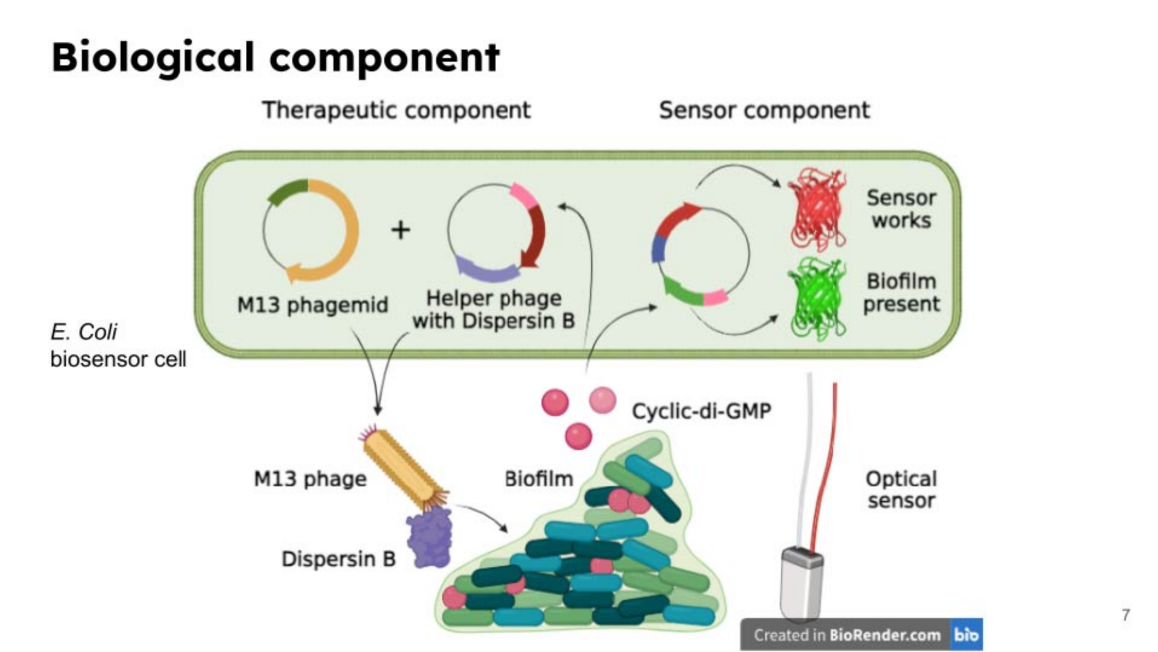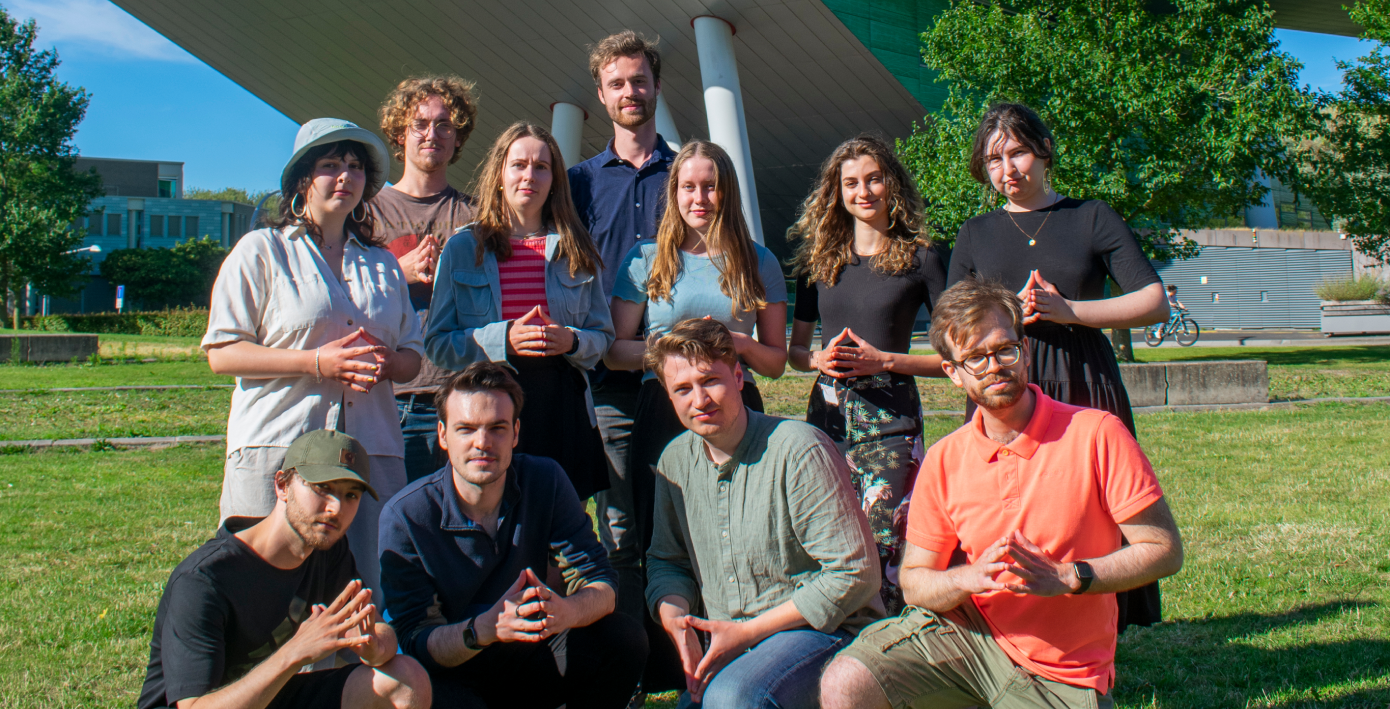Saying bye to biofilm
When medical implants are infected, a layer of harmful bacteria forms on the surface of the implant: a biofilm. A team of 14 passionate graduate and undergraduate students from the University of Groningen and Minerva Art Academy took part in the International Genetically Engineered Machine Competition (iGEM) to tackle this problem. From November 2nd to 5th they will travel to Paris to present their final project to a panel of experts in the field of synthetic biology. Their name? Bye-o-film.
Science Newsroom | Myrna Kooij
With a faster-growing population of 65 and over and obesity becoming a larger problem, medical implants are becoming more frequently used tools to replace worn-out joints. According to the team, 87,884 joint replacement surgeries were performed in the Netherlands in 2022 and 2% of the patients who underwent this type of procedure, developed implant-related infections. An infection can cause the formation of a layer of biofilm on the implant. This layer consists of a collection of harmful bacteria that infect the surrounding tissue. When this happens, a revision surgery is needed to be able to slow down the infection and treat it – a costly and invasive method. On top of that, these infections are difficult to detect and treat with antibiotics as the bacteria involved can become antibiotic-resistant. Therefore this biofilm formation presents an interesting problem waiting to be tackled.
“I just had a course on chemical biology and I thought: maybe we can use some of this.”
Bye-o-film
The team started brainstorming about possible topics in early February. They wanted to work with biosensors because of their prior knowledge about it. Team member Ingrid Budau explains that she brought infections related to medical implants to the design table after she had a discussion about it with a friend. She adds: “I just had a course on chemical biology and I thought: maybe we can use some of this.”
The team collectively worked out different components of the product design. They eventually came up with the idea of a biosensor that can detect and treat the infection in an implant and say a final “Bye” to the formation of biofilm. Their name Bye-o-film was born.

Biosensor
The team designed a fluorescent biosensor with a biological and electronic component: it senses a biological signal (a biological compound) and transforms this into an electronic signal. An example of a common biosensor is the device used by diabetic patients to measure their blood glucose levels. Team member Thomas Westerhuis explains that their sensor is “able to talk along with the bacteria that are going to infect an implant.” It measures the presence of cyclic-di-GMP, a molecule that signals the formation of a biofilm layer. When this molecule is picked up by the sensor. it starts producing light. This light can be picked up by the electronic component which sends the information to your phone. For the biosensor, the team used a promotor from a Chinese iGEM team of 2022 that can sense molecules secreted by infectious E. coli cells during the formation of biofilm.
The Bye-o-film team developed their own software for a complementary app that can notify the patient when a biofilm layer is being formed. A notification instructs them to go and see a doctor to receive a check-up of their implant. Next to that integrated human practices are a big part of their project. The team had meetings with researchers, conducted surveys with patients, and received feedback from specialists which they all implemented into the final design of their biosensor.
“It’s an engineering competition and with engineering you have a prototype, you test, you troubleshoot. Things are not going to work the first time, also not the 2nd time and in our case also not the 3rd or 4th time, but that is the process.”
Their realised prototype succeeded in a lab setting but still needs further improvement to detect and treat infections inside patients with medical implants. “We wanted to have proof of concept that we can make a biological signal and transfer it to an electronic signal and really send that to someone's phone,” explains Westerhuis. Some things still need to be worked out, such as generating the fluorescent proteins in the tissue cells and some issues with the promotor that they used from the previous Chinese iGEM team. Budau explains: “It worked in their conditions and the way they did it, and when we tried to do it and it didn’t work, your world is falling apart.” They discussed it with their supervisors and went back into the lab to redesign the biosensor. Westerhuis emphasises that in iGEM the E stands for engineered: “It’s an engineering competition and with engineering you have a prototype, you test, you troubleshoot. Things are not going to work the first time, also not the 2nd time and in our case also not the 3rd or 4th time, but that is the process.” He adds: “It’s also one of the criteria of iGEM and it’s a part of a project like this.” Next year a new iGEM team can build upon the basis of Bye-o-film’s concept design and develop it further into a final product.

The Bye-o-film team consists of a multi-disciplinary group of 14 students, each with a different background ranging from a BSc in Design at Minerva Art Academy to a MSc in Biomolecular Sciences at the University of Groningen. They divided the tasks based on each individual's level of expertise and own interest and had different subgroups like the Wet Lab, Electronics and human practices team. Westerhuis states: “Every step of the way you could see that people had their own part to contribute with their own set of things they excel at.”
Westerhuis is doing a MSc in Biomolecular sciences and his tasks involved being a treasurer, fundraising and working in the wet lab. He had already heard about iGEM when he was still a student at the Hanze. “Then the teams still travelled to Boston,” says Westerhuis. His passion for iGEM lies in the science-based entrepreneurial part. “You focus not only on what you do in the lab but also focus on what kind of an impact you have.” He learned about the technical aspects of the project. “Do you have the equipment? Do you have the funds?” The ambitious aspect of the project is what appealed to him and why he applied.
Budau is a MSc student in chemistry and was involved in designing the biochemical and electronics components and also worked in the wet lab. She joined the team to “get some hands-on experience on what it means to come up with your own idea, to design it and test it.” She enjoys doing research, being part of a big team, and having an international community. She appreciates the opportunities to meet these people from other countries all working towards a similar goal, and she is looking forward to going to Paris.
The team is guided by Julia Kamenz (PhD and student supervisor), Sonja Billerbeck (Primary PI) and Patricia Alvarez Sieiro (Secondary PI). Although these last two both hold the title of Principal Investigator, which typically addresses the lead researchers of a project, their role is mostly advisory. In the iGEM project, the big decisions are made by the students themselves giving them full control over their own project design and development.
World Expo in Paris
From November 2nd to 5th, the team will travel to Paris to present their project during the World Expo of synthetic biology. To help promote their Biofilm project in Paris they will bring along their self-designed t-shirts and stickers. They already handed in their 15-minute video in which they present their Bye-o-film project, see the video above. The jury of experts will watch this video to score their project and decide whether they earn a medal or award. Currently, the team is still working on finetuning their 5-minute pitch in which they will present the value of their project. Will they be able to convince the jury of their value and win the awards? If you'd like to follow their adventure, go follow the Bye-o-film team on Instagram or LinkedIn and check out their entire project on their wiki page.
Sources:
Bye-o-film team and their wiki page

| Last modified: | 02 November 2023 2.34 p.m. |
More news
-
10 June 2024
Swarming around a skyscraper
Every two weeks, UG Makers puts the spotlight on a researcher who has created something tangible, ranging from homemade measuring equipment for academic research to small or larger products that can change our daily lives. That is how UG...
-
21 May 2024
Results of 2024 University elections
The votes have been counted and the results of the University elections are in!

